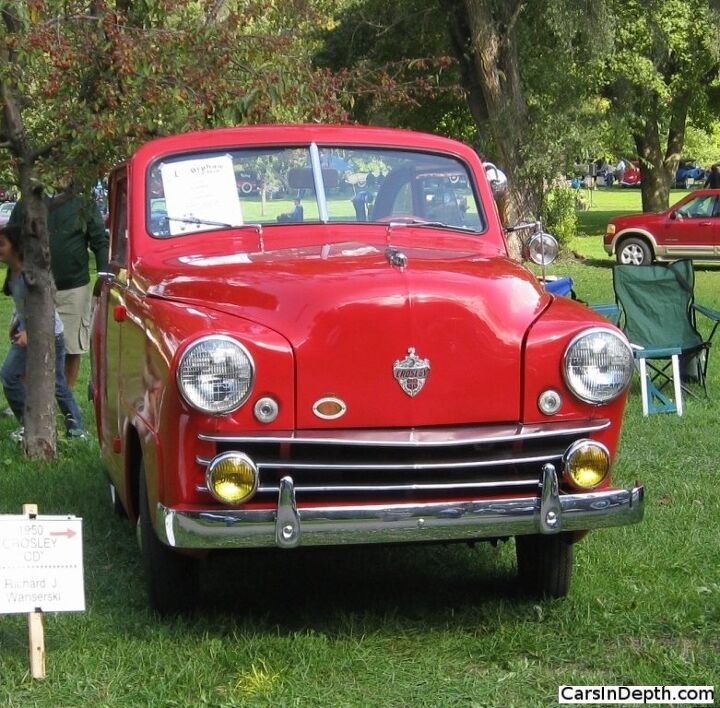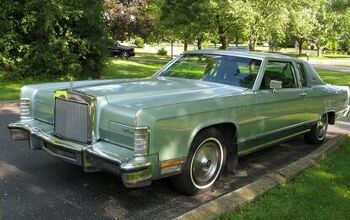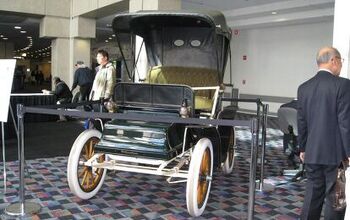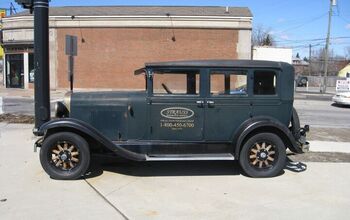Look At What I Found!: 1951 Crosley Hotshot

Foodies start restaurants. Most new restaurants fail. Gearheads’ most common business dream/fantasy may be starting up a new car company. Those usually fail too. The appeal has attracted diverse entrepreneurs with near addictive quality, and with nearly the same ruinous results as a physical addiction. For every Walter Chrysler, there is at least one Henry J. Kaiser. For every Colin Chapman there has been a least a couple of Malcolm Bricklins. Bricklin’s own attempt to build a safety car was predated by that of Preston Tucker. Bricklin actually sold a lot more cars than Tucker ever did. That’s not even counting the frauds like “Liz Carmichael” and the Dale. Powell Crosley Jr. also caught the car building bug, and was both more successful and more influential than most of those dreamers.
1940 Crosley convertible
Crosley had an early interest in automobiles and before 1920 made a number of failed attempts to make cars. He was more successful, though, selling gadgets and accessories in the automotive aftermarket, creating the foundation for his later ventures. In the early 1920s when his son wanted a radio, the latest fad, Crosley discovered how expensive they were and started to apply mass production techniques borrowed from Henry Ford, first to make radio components, and later complete radios. By 1924 Crosley was the largest radio manufacturer in the world. The Crosley brand was so well established that nearly a century later, a modern company selling retro consumer electronics is now using the name.
1951 Crosley Hotshot
Photo courtesy of Cars In Depth
From selling radio receivers, Crosley went on to the content side of what was then modern communications and started a 50 watt radio station, WLW, which would eventually blanket the entire United States, using a signal ranging as high as 700,000 watts. The strength of that signal was one factor in the wide popularity of the Cincinnati Reds baseball team, which by then Crosley had bought. His financial fortunes well established, Powell Crosley returned to his original dream of making a car of his own.
1950 Crosley CD
Working with his brother Lewis, a graduate engineer, in the late 1930s Crosley developed an inexpensive subcompact car. Production started in 1939 at two Indiana factories and by the time the switch to military production in World War II put an end to most consumer manufacturing, Crosley had sold nearly 5,000 Crosley sedans, coupes, convertibles and station wagons. Much like celebrities today flock to startups like Tesla, Crosley cars had many famous owners including Gen. Omar Bradley, former general Pres. Dwight Eisenhower, famed architect Frank Lloyd Wright, politician Nelson Rockefeller and entertainers Gloria Swanson, Humphrey Bogart and Art Linkletter.
Crosley cars may have been cheap (the first Crosleys cost only $250) but the company was unquestionably a technological and automotive marketing pioneer with many “firsts”. Beside selling the first successful subcompact car in the US, Crosley introduced the first use of the term ‘Sport Utility’, the first mass-market single overhead camshaft engine in 1946, the first slab-sided postwar car, the first all steel-bodied station wagon in 1947 (earlier wagons used wood framing under the steel panels), and the first American car to be fitted with 4-wheel disc brakes in 1949, standard on the first American sports car, the Hotshot, introduced in 1949. Crosley even anticipated UTVs like the John Deere Gator with the Farm-O-Road model, a 63-inch wheelbase utility vehicle. All of this is in addition to the novel COBRA engine which Powell developed during WWII, whose cylinder block was made up of steel stampings, copper brass welded together. It showed promise but reliability issues prompted a switch to cast iron.
Crosley COBRA engine on display in the Indiana Cars hall of the Auburn Cord Duesenberg Automobile Museum, Auburn, IN
The Hotshot cost half ($900) of what a base Chevy cost then. It’s diminutive size and price did not deter owners from using the little two seater in competition, rather successfully I might add, winning both the Index of Performance and taking overall victory at the first Sebring 6-hour race in 1950. Other notable results included victory in the 1951 Swiss Grand Prix and second in the 1951 Tokyo Grand Prix.
Crosley engines also powered a number of racing specials, including those built by Bandini, Moretti and Siata. The Crosley powered specials were very successful with a Siata/Crosley winning the 12-hour SCCA race at Vero Beach, while a Bandini/Crosley won the 6-hour event. Crosley specials also led the SCCA H-modified class throughout the late 1950s, and at Bonneville, a Crosley-powered “belly tanker” significantly increased the Class O record to almost 100 miles per hour.
1952 Crosley Station Wagon
Crosley’s best year was 1948, during the postwar car sales boom when consumers were buying anything new that was available after years of wartime rationing and most consumer industries switched to military production. Crosley sold almost 25,000 cars that year. As more and more of the established (and startup) automakers introduced all new postwar designs, Crosley sales started to decline even after the Hotshot was introduced in 1949 and the Farm-O-Road the next year. Nash’s introduction of the compact Rambler didn’t help things. By 1952 sales had dropped to only 1,522 cars, with production ending in July of that year.
Famed architect Frank Lloyd Wright’s 1952 Crosley Super Roadster, in Taliesin Red, just like his Cord L-29 in the background
Considering what restored VW Beetles and Buses are getting today, the $15,000-$20,000 that a restored Hotshot or other Crosley will cost you seems to me to be a reasonable price for a unique and very historic automobile.
Ronnie Schreiber edits Cars In Depth, a realistic perspective on cars & car culture and the original 3D car site. If you found this post worthwhile, you can dig deeper at Cars In Depth. If the 3D thing freaks you out, don’t worry, all the photo and video players in use at the site have mono options. Thanks for reading – RJS
1950 Crosley CD
1940 Crosley convertible
1952 Crosley Station Wagon
1952 Crosley Station Wagon with COBRA engine in foreground
Famed architect Frank Lloyd Wright’s 1952 Crosley Super Roadster, in Taliesin Red, just like his Cord L-29 in the background

Ronnie Schreiber edits Cars In Depth, the original 3D car site.
More by Ronnie Schreiber
Latest Car Reviews
Read moreLatest Product Reviews
Read moreRecent Comments
- MaintenanceCosts In Toyota's hands, these hybrid powertrains with a single motor and a conventional automatic transmission have not been achieving the same kind of fuel economy benefits as the planetary-gear setups in the smaller cars. It's too bad. Many years ago GM did a group of full-size pickups and SUVs with a 6.0L V8 and a two-motor planetary gear system, and those got the fuel economy boost you'd expect while maintaining big-time towing capacity. Toyota should have done the same with its turbo four and six in the new trucks.
- JMII My C7 isn't too bad maintain wise but it requires 10 quarts of expensive 0W-40 once a year (per GM) and tires are pricey due size and grip requirements. I average about $600 a year in maintenance but a majority of that is due to track usage. Brake fluid, brake pads and tires add up quickly. Wiper blades, coolant flush, transmission fluid, rear diff fluid and a new battery were the other costs. I bought the car in 2018 with 18k in mileage and now it has 42k. Many of the items mentioned are needed between 20k and 40k per GM's service schedule so my ownership period just happens to align with various intervals.I really need to go thru my service spreadsheet and put track related items on a separate tab to get a better picture of what "normal" cost would be. Its likely 75% of my spend is track related.Repairs to date are only $350. I needed a new XM antenna (aftermarket), a cargo net clip, a backup lamp switch and new LED side markers (aftermarket). The LEDs were the most expensive at $220.
- Slavuta I drove it but previous style. Its big, with numb steering feel, and transmission that takes away from whatever the engine has.
- Wjtinfwb Rivaled only by the Prowler and Thunderbird as retro vehicles that missed the mark... by a mile.
- Wjtinfwb Tennessee is a Right to Work state. The UAW will have a bit less leverage there than in Michigan, which repealed R t W a couple years ago. And how much leverage will the UAW really have in Chattanooga. That plant builds ID. 4 and Atlas, neither of which are setting the world afire, sales wise. I'd have thought VW would have learned the UAW plays by different rules than the placid German unions from the Westmoreland PA debacle. But history has shown VW to be exceptionally slow learners. Watching with interest.






































































































Comments
Join the conversation
Interesting cars , as stated Crosley was an innovator but the vehicles were *so* wretchedly cheap and tinny , I never was enthusiastic about them . -Nate
Crosley was ahead of his time with these smaller cars. The might have been cheap and tinny but some of the Ramblers were as well. There were some poorly finished cars in the 40's and 50's as with the 70's and 80's. Many of these were priced lower to appeal to the price conscious consumers.